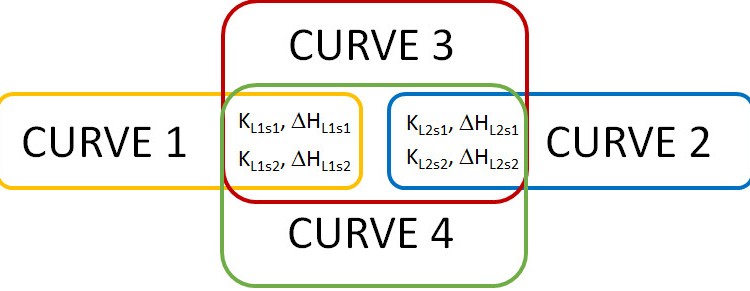ITC displacement titrations offer an attractive alternative to standard assays when working with ultra high- or ultra low- affinity interacting systems. The method requires the fitting of at least two isotherms that share various adjustable parameters. AFFINImeter counts with advanced tools, like the global fitting of multiple dataseries and the analysis of isotherms registered under unusual experimental design, which can facilitate the analysis and expand the range of applications of isothermal titration calorimetry experiments. As an illustration, herein we present a displacement titration assay to determine the thermodynamics of HIV-protease with indinavir, a high affinity binder, and with acetyl-pepstatin, a weaker ligand. Using AFFINImeter a global analysis of four isotherms was performed describing: HIV-protease binding to indinavir (I) or to acetyl-pepstatin (II): HIV-protease binding to indinavir incorporating acetyl-pepstatin in the cell (III) or in the syringe (IV).
Isothermal Titration Calorimetry is one of the most commonly used approaches to obtain affinity and thermodynamic data of molecular interactions and has become a routine method in the pharmaceutical industry.1 Isothermal titration Calorimetry is applicable to numerous interacting systems, as long as a detectable heat change is produced during complexation, covering an important range of binding affinities (106 ≤ KA ≤108 M-1). Nevertheless, standard ITC experiments present some limitations in the case of very low- or very high-affinity interactions (i.e. affinities in the low millimolar or high nanomolar range, respectively). High affinity interactions (KA ≥ 109 M-1) yield square-shaped isotherms whose fitting yield accurate values of the binding enthalpy but only estimates of the association constant. Attempts to recover a sigmoidal shape requires the use of very low concentrations of the interactants that, in most cases, is not feasible in the practice (the minimum concentration that will typically cause a confidently measurable heat change for a 1:1 interaction is about 10 μM). On the opposite, low affinity interactions should be studied at high concentrations and this requirements is often a serious limiting step due to various potential reasons like limited solubility and/or availability of the sample molecule, or the existence of aggregation processes at the required concentration. In both high- and low affinity systems these experimental drawbacks can be circumvented by using the ITC displacement method.2,3 Here, the receptor is titrated with a high affinity ligand, but in the presence of a weaker ligand in the sample cell that competes for the complexation with the receptor (figure 1). With this experimental set up the apparent affinity of the strong ligand is “artificially” lowered, obtaining a sigmoidal isotherm that yields more accurate binding data. When the goal is to obtain the thermodynamic parameters of an ultra highaffinity system, a titration with the weaker binder is performed first to obtain the corresponding affinity constant and enthalpy (KA-weak and H-weak). These values are required for the analysis of the ITC displacement experiment, where a competitive binding model is used to estimate the thermodynamic parameters of the tight binding (KA-tight and H-tight). Analogously, when the goal is to obtain information of an ultra low- affinity system a direct ITC titration of the receptor alone with a ligand of higher affinity is performed. The resulting KA-tight and H-tight are then incorporated in the analysis of the isotherm from the ITC displacement assay.
This case study exemplifies the potential advantages of using AFFINImeter in ITC displacement assays. The software offers unique advanced tools that enhance the robustness of the method and makes it more versatile, facilitating the acquisition of reliable thermodynamic data from ultra-high of ultra-low affinity systems. Thus, it opens a door for new applications of the displacement assay.
1 G. Holdgate, S. Geschwindner, A. Breeze, G. Davies, N. Colclough, D. Temesi, L. Ward, Biophysical Methods in Drug Discovery from Small Molecule to Pharmaceutical. Protein-Ligand Interactions. In Methods in Molecular Biology 2013, 1008, pp 327-355.
2 A. Vellazquez-Campoy and E. Freire, Isothermal titration calorimetry to determine association constants for highaffinity ligands. Nature protocols 2006, 1, pp 186-191.
3 W. B. Turnbull, Divided we fall? Studying low-affinity fragments of ligands by ITC. GE Healthcare Life Sciences protocol.

